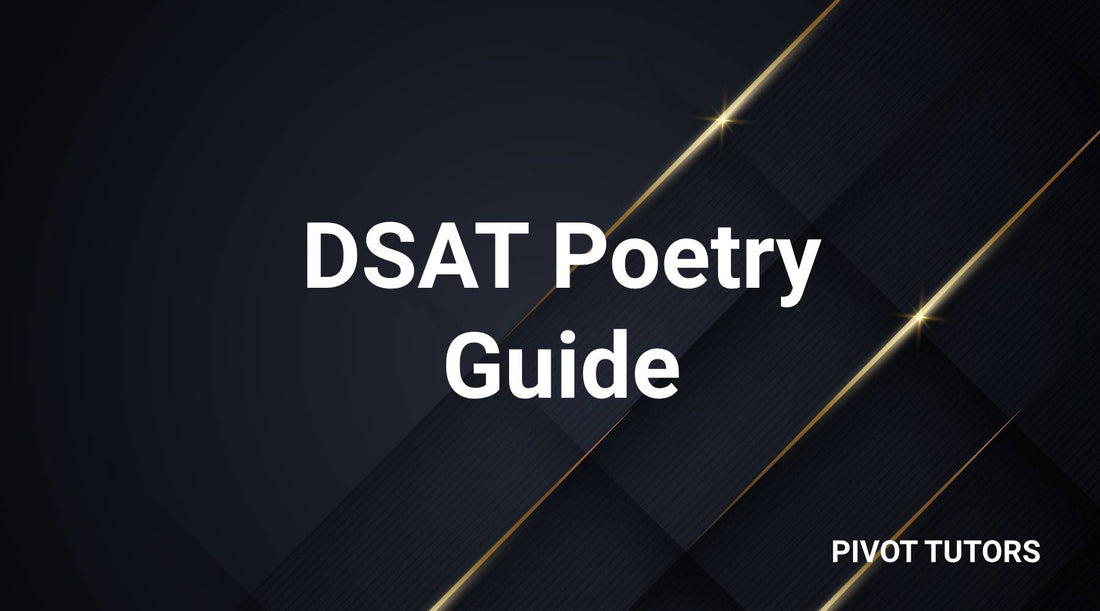By Saige Brown
Poetry can oftentimes feel confusing and wordy, especially if you aren’t a big fan of figurative language. You may have encountered it out in the world or online, but more than likely your introduction to it would have been through school. English classes, especially those in high school, will frequently have poetry sprinkled throughout the lessons as a supplement to the prose being discussed. Maybe it’s your favorite part of the class, or maybe you dread discussing it. Whatever your comfort level with poetry, it is important to understand how to decipher it and break it down into more manageable, understandable parts.
With the DSAT format, poetry-based questions have been introduced as a brand-new type to contend with. These questions are designed to test not only your reading comprehension skills but also your ability to use rhetorical analysis to find the deeper meanings in works of poetry. As with all DSAT questions, the piece you’ll be analyzing only pertains to one question. Thus, it is important to develop your ability to read and break down texts in an efficient and timely manner. Whether you want to hone your skills when it comes to understanding figurative language, or you’re actively studying for the DSAT, this guide is designed to help you reach the best understanding possible!
Question Types
Though all of the poetry questions reference their respective poems, there are a few different question formats the DSAT can pose about the pieces themselves.
- Main Purpose
These are the most common questions you can encounter when discussing poetry on the DSAT. They are usually phrased along the lines of “Which choice best states the main purpose of the text?” With main purpose questions, the key to understanding them is to look over the text as a whole, searching for what the author could have wanted to convey or claim.
- Underlined Portion
These questions, unlike with main purpose questions, are focused on an individual underlined portion. They are usually phrased along the lines of “Which choice best describes the function of the underlined portion in the text as a whole?” When approaching this kind of question, it is important to take the underlined line or lines into context with the words around them as oftentimes they will give clues about what the underlined section may mean.
- Structure
Though these questions may sound similar to main purpose questions, they have one key difference that sets them apart. Where main purpose questions are about the point of the poem, structure questions ask about the design of the poem – how it is set up by the author to function as a piece. They are usually phrased along the lines of “Which choice best describes the overall structure of the text?” To answer these question types, you need to look at how the poem is formatted and ask yourself how the way it is set up affects the way readers interpret it.
Examples
To better illustrate how to apply certain helpful strategies to each possible question type, we’ve curated some examples that do just that!
Main Purpose:
The following text is adapted from Emily Dickinson’s 1863 poem “Because I could not stop for Death.”
Because I could not stop for Death –
He kindly stopped for me –
The Carriage held but just Ourselves –
And Immortality.
We slowly drove – He knew no haste
And I had put away
My labor and my leisure too,
For His Civility –
Which choice best states the main purpose of the text?
In this case, the answer is (D).
Let’s break this piece down bit by bit!
“Because I could not stop for Death - He kindly stopped for me -” is saying that the speaker is not able to stop death, but Death as a personified being can stop for the speaker, meaning that they will not yet die. “The Carriage held but just Ourselves - and Immortality” details a metaphorical carriage where the speaker and the personified Death are sitting together along with Immortality, another personified being that cannot beat Death because it is in his carriage. “We slowly drove - He knew no haste” is saying that death is not in a rush, meaning that the speaker will not die anytime soon. “And I had put away My labor and my leisure too, for His Civility” is saying that the speaker knows that at the end of their life, their work and their personal time will not affect the fact that they will inevitably die, meaning that death comes for everyone eventually, but it doesn't have to be scary. This makes (D), To show that death comes for everyone eventually, the correct answer.
Underlined Portion:
The following text is adapted from Robert Frost’s 1915 poem “Birches.”
One by one he subdued his father's trees
By riding them down over and over again
Until he took the stiffness out of them,
And not one but hung limp, not one was left
For him to conquer. He learned all there was
To learn about not launching out too soon
And so not carrying the tree away
Clear to the ground. He always kept his poise
To the top branches, climbing carefully
With the same pains you use to fill a cup
Up to the brim, and even above the brim.
Which choice best describes the function of the underlined portion in the text as a whole?
In this case, the answer is (B).
Let’s examine the function of the underlined portion in the context of the poem!
The poem details how a boy plays on the trees that his father owns and how the trees behave over time. When we're looking at the function of the underlined portion, we need to apply it to the context around it. We know from the lines “riding them down over and over again” and “not one was left for him to conquer” that the boy has climbed on every tree his father owns and the underlined portion “until he took the stiffness out of them” exemplifies how often the boy climbed those trees. This makes (B), It shows how much the boy climbed the trees, the correct answer.
Structure:
The following text is adapted from Maya Angelou’s 1978 poem “Still I Rise.”
You may write me down in history
With your bitter, twisted lies,
You may trod me in the very dirt
But still, like dust, I'll rise.
Does my sassiness upset you?
Why are you beset with gloom?
’Cause I walk like I've got oil wells
Pumping in my living room.
Which choice best describes the overall structure of the text?
In this case, the answer is (C).
Let’s analyze the structure of the poem!
The first stanza serves to detail how people may treat the speaker negatively as well as display her willingness to rise up against said people. The people can lie about her in history or slander her name by metaphorically rubbing it in the dirt, but she will still remain resilient, hence rising like the dust. The second stanza serves to detail the speaker questioning why those she is addressing are displeased with her resistance against their treatment of her. The questions are not genuine, but rather, are rhetorical questions that this speaker already knows the answer to. She knows that they are upset by the way she acts. She uses the simile “’Cause I walk like I've got oil wells pumping in my living room” to show that she carries herself like she is worth a lot. Oil is well known to be extremely expensive, so if she owned any then she would be quite wealthy. However, the wealth she is demonstrating is not physical or monetary. Instead, she has a wealth of self-worth and self-confidence, hence why the people she is addressing are upset because they are trying to break her down, and it isn't working. This makes (C), The speaker decides that she will resist those who try to silence her, then sarcastically wonders why they are upset, the correct answer.
Takeaways
As you can see from our examples, each question variation about poetry requires a certain level of rhetorical analysis and the ability to “read between the lines.” Looking into the deeper message is a key factor in understanding what the poem means. That way, when a question is posed to you, no matter what format, you’ll know what you’re working with.
It is important to read the question before you read the poem so that you know what is being asked of you and what to keep an eye out for. Then when you read through the poem itself, be sure to consider what each line means individually as well as in the context of the stanza. Oftentimes, these questions tend to take a bit longer than others because they require closer reading, but if you apply the strategies suggested here, your ability to not only answer but also understand these question types will greatly improve! Keep practicing with poetry questions to hone your analytical skills. Who knows? You may find some poems you really enjoy! Happy reading!

